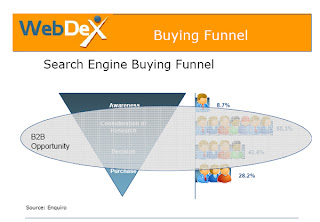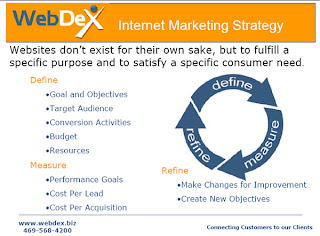Day 3
4:30 – 6pm
B2B Marketing Tactics – No consumers allowed! This was a great business to business session, B2B is a more “soft sell” and requires different strategies. The inquiry is further out from the buy, or the deal. Here are issues discussed, lead by moderator Gordon Hotchkiss:
3 Speakers:
Patricia Hursh, SmartSearch Marketing
Paul Slack, WebDex
Karen Breen Vogel, ClearGauge
How is b2b (biz to biz) different than b2c (biz to consumer)? Goals are different first of all, you’re starting or developing relationships. Major search engines aren’t your main focus all the time, you need to delve down and look at business.com and specific search engines in specific verticals. Think buying cycle and role bases keywords. We need to consider pain point keywords, not just problem solutions in B2B scenarios. Messages are different…the value proposition or offer. Think like you’re on the 2nd or 3rd date with visitors, instead of the marriage proposal. Treat them accordingly.
64% of Search Engine searchers are looking for business info. Just because your site doesn’t have a “cash register” ringing, you can still bring in dollars. If your business is not optimizing, you are leaving MOST of your chips on the table.
Recommendations for B2B are to go organic SEO first, and wrap your PPC around it.
Challenge: Keyword selection. Think: who are you really messaging for? Offer segmentation options.
Challenge: Low sample sizes in B2B. solution is to do landing page testing and message, notsomuch multivariable testing. (good, that makes my head spin, its not really CCWD’s niche of clients) use vertster.com (funny, vert means green en franciais) to check a-b and multivariate tests you run
Get VERTICAL. Google is great; but those vertical engines are your exact target market. They may be small, but the users are all much more likely to be your client. Google results may be large, but not nearly as many users are likely to be your client. Make sure you are in your niche’s search engine.
A problem with B2B PPC is that people don’t always read the ad. If you say your websites start at $5000, and someone signs your contact form with a $2000 budget, do you just ignore them? You shouldn’t, you should find someone else to refer them to and get a referral fee. After all, you paid for them 🙂
Create a value point system. Track your volume, and assign values to your visitors. Assign points to clickthroughs, to forms, to leads, and points to conversions. Then assign dollars. This will help a business decide how much “a click” or how much “a visitor” costs.
Karen offered her full whitepaper report email: Karen.breenvogel@cleargauge.com
Next up was Paul with WebDex, he surveyed the room. Lots of in house B2B people here. B2B means you are looking for leads from a site, not dollars. So Real Estate is considered B2B by his definition.
B2B sales cycle – look at the inverted triangle – the middle sections are the B2B sweet spot:

There are 2 critical players within the sweetspot: influencers and decision makers. Influencers do very specific searches, and are more likely to convert.
Decision Makers do high level searches with 2 or 3 words. They are less likely to respond to a call to action, they prefer to pick up the phone and call. Sources of content they look at is your home and about pages.
What can we do to catch more influencers and decision makers? The circle slide was nice:

Define your site. Its really not about you, its about your user. What knowledge does your target audience want?
Refine. and keep refining, and keep re-refining.
Measure. I gave Paul my card to email for the cost per acquisition spreadsheet! It will prove internet marketing vs print marketing.
Patricia Hursh was up next, talking about B2B trends. She reminded everyone that when it comes to B2B, if you use Google you are looking for a “needle in a haystack”, but if you are using a B2B engine, you are looking for a “needle in a needle stack”. It’s so much more relevant.
An overview…..
B2B marketing trends – search marketing is #11 on the list of SEO. Most go to trade shows (holy expensive!). SEO was #2 on the list of “to dos” for B2B, though.
Think beyond the click – find – drive – convert – measure. Think post click, pre-click is still good but post-click is where the money really is. Focus on your Conversions and measures!!
4 ways to improve your B2B results:
Map visitors needs to solutions. Identify types of visitors, assess their needs and pain points across the entire buying cycle. Associate their needs with your assets, information and actions. Nice picture, map the things your company has to offer. Whitepaper, VT, pdf’s, all of it.
Offer action options.
Remember sometimes people aren’t ready to download your main goal, so offer OPTIONS. Offer a webinar, or a tour, or something small. Baby steps. Its like courting, remember? Don’t try to feel the girl up on the first date, sleezy 🙂
Simplify registration forms. Remember, you don’t have to get ALL their information right NOW, you can earn it later. Try just getting their email first. Offer people a “choice” to fill out more info with added value for a neat tips and tricks form or something.
Consider a ROBUST follow up process and getting less data in the beginning. I love this concept, and as an online user I live by it too. I will give you what you need upfront, and if I think you should have more, I will offer it if you add value to what you are offering me 🙂
Improve landing pages (continuously). Improve look and feel, layout, IMAGES, messages, CTA’s, forms, names and descriptions for downloadable assets. Change the name of the thing they are downloading. For one case study, conversions doubled from going from the word “information”… to “tour”…and then to “virtual tour”. Way to be an SEO hero, doubling conversions by changing 2 words. Its the little things that count in our little geektown! 🙂
Tips and tricks for SEO’s:
It was also suggested to mystery shop our client’s sites, because B2B small and medium sized clients drop the ball all the time. How? By not answering form inquiries or incoming calls from the site. I’m totally guilty, I hate to be a slave to email. I try to hire assistants but they don’t want to do my emails either. Damn 🙁
Brad Coleman showed me a survey “what buyers want” that states real estate buyers expect a call back in 15 minutes or they think you are a slacker. sigh… it takes buyers 15 touches (minimum!) for them to contact us, and then they want us in 15 minutes. Geez. Sometimes SEO clients have to up your game, and implement new service systems. Even if you double contacts for a client, they will still not increase business. Its not always the SEO fault, sometimes its something internal.
Try interactive conversations, they are working well for tech categories. They not only allow users to easily give info, it allows them to get some info from you.
Differentiate between “inquires” and “leads”. I like this concept. Inquiries are a process, leads are solid… and almost ready to go. Not every sign up or sign in is a LEAD. Most B2B goals are more toward inquiries, they should be put on a solid automated campaign…because many will never become clients.
Get on wikipedia for good b2b links
Say to doubters in the company when you need to make changes “you’re probably right, but shouldn’t we test this?”
Whitepapers work VERY well, (this suprises me I hate to kill trees) because people are often researching and reporting. And moving things up the flagpole.
Implement a feedback process to monitor invalid emails, bad numbers, and come up with a verified list. Then qualify those leads, and many will go away again. It’s a qualification funnel, monitor it and clients will better understand what they get for their money. 🙂



